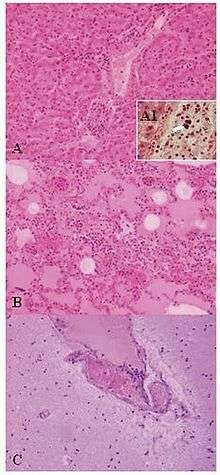Weissella
Weissella[2] is a genus of gram-positive bacteria, placed within the family Leuconostocaceae, and formerly considered species of the Leuconostoc paramesenteroides group.[3] The morphology of Weissella species varies from spherical or lenticular cells to irregular rods. Several strains of Weissella cibaria and Weissella confusa have shown the probiotic potential [4]. In particular, the cell-free culture supernatant of Weissella confusa shows various beneficial characteristics such as antibacterial potential and anti-inflammatory efficiency [5]. However, there are few strains of W. confusa was also found as an opportunistic bacteria. On the other, several studies have also done the safety assessment of the bacterial species and have proved it's probiotic potential [6]. In addition, the Senate Commission on Food Safety has also validated the usage of W. confusa in the food [7]. Therefore, there is a need for more investigation to use bacterial species in the food industry.
| Weissella | |
|---|---|
 | |
| Lesions of Weissella confusa in the mona monkey (hematoxylin and eosin stain): A) liver: portal triads with neutrophilic infiltration (x10); A1, presence of bacterial emboli inside the vein (arrow) (x40). B) acute pneumonia: edema, congestion, and leukocyte cells exudation in the pulmonary alveoli (x10). C) encephalitis: congestion and marginalized neutrophils in nervous vessels (x10) | |
| Scientific classification | |
| Kingdom: | Bacteria |
| Division: | |
| Class: | |
| Order: | |
| Family: | |
| Genus: | Weissella Collins et al. 1994 |
| Species | |
| |
References
- Parte, A. C. "Weissella". www.bacterio.net.
- Björkroth, J., and W. Holzapfel. 2006. Genera Leuconostoc, Oenococcus and Weissella, p.267 -319. In M. Dworkin (ed.), The prokaryotes: a handbook on the biology of bacteria: Firmicutes, Cyanobacteria, vol. 4, 3rd ed. Springer-Verlag, New York, NY.
- Collins, M.D.; Samelis, J.; Metaxopoulos, J.; Wallbanks, S. (1993). "Taxonomic studies on some leuconostoc-like organisms from fermented sausages: description of a new genus Weissella for the Leuconostoc paramesenteroides group of species". Journal of Applied Microbiology. 75 (6): 595–603. doi:10.1111/j.1365-2672.1993.tb01600.x. ISSN 1364-5072. PMID 8294308.
- Lee KW, Park JY, Jeong HR, Heo HJ, Han NS, Kim JH. 2012. Probiotic properties of Weissella strains isolated from human faeces. Anaerobe, p.96-102
- Dey DK, Khan I, Kang SC. 2019. Anti-bacterial susceptibility profiling of Weissella confusa DD_A7 against the multidrug-resistant ESBL-positive E. coli. Microb Pathog,p.119-130
- Dey DK, Koo BG, Sharma C, Kang SC. 2019. Characterization of Weissella confusa DD_A7 isolated from kimchi. LWT, p.663-672
- Vogel RF, Hammes WP, Habermeyer M, Engel KH, Knorr D, Eisenbrand G. 2011. Microbial food cultures--opinion of the Senate Commission on Food Safety (SKLM) of the German Research Foundation (DFG). Mol Nutr Food Res, p.654-662
External links
- List of species of the genus Weissella
- Weissella confusa Infection in Primate (Cercopithecus mona)
- "Weissella" at the Encyclopedia of Life
